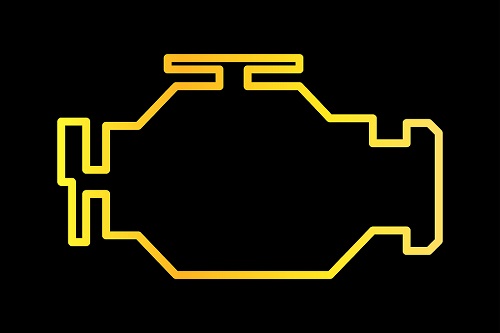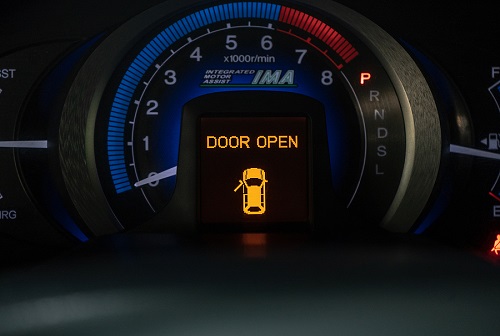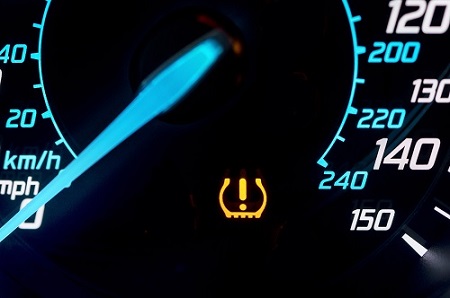Whenever you turn the ignition key in your car, or press the start button, you should see a full Christmas tree’s worth of warning and sensor lights pop into life on the dashboard. If all is well, these lights will quickly switch back off again and you’re off to the shops, to work, to school, or maybe just out for a nice drive. Hopefully if you've just purchased a car you've done your due diligence and performed a car check too.
When the lights don’t turn off is when you need to start worrying. Many of us will, at first, ignore a warning light on our dashboards, willing them to just go away, in the hope of putting off an unexpected and unwanted cost, but it’s like the early twinges of tooth-ache — the longer you leave calling the dentist, the worse the time in the chair is going to feel. Here are the nine car warning lights you really shouldn’t ignore…
1. Check engine.

This light is technically known as the Check Engine Light (CEL) or Malfunction Indicator Light (MIL) and it’s usually the outline shape of an engine, lit up in either red or yellow (in some cars, usually only US market models, the words ‘Check Engine’ might light up). While in some cases, and on some models (check your owners’ handbook to be sure…) a yellow light can mean that the problem is one that needs attention soon, rather than right now, a check engine light in either red or yellow means you really should just switch off and call for help — the problem can be anything from a mechanical issue with the ignition timing or cambelt, or it could be a serious issue with oil pressure (in both cases other lights should be lit up, which will help you figure it out) but in any event it’s very likely a major engine fault and the car is not safe to be driven. Most modern cars will go into ‘limp home’ mode at this point, allowing you to drive a very short distance on minimal power to get safely off the road. If you’re lucky, it will just be a faulty sensor that needs replacing or rebooting, but if it’s a more serious issue you will thank yourself for not trying to drive the car with this light lit up.
2. Brakes
This warning sign will be a red circle, with the letter P or an exclamation mark in the centre, with two curved lines at the side, which look like brackets. There is also a similar light, with the letters ABS in the centre, which usually lights up in yellow. Whichever one flashes up, don’t try driving anywhere — there is a fault with your brakes, which could be brake pads that have worn down beyond their minimum, or perhaps a loss or blockage of brake fluid, but it’s definitely too dangerous for you to start driving anywhere as there’s a very real danger you won’t be able to stop. The ABS light means that you can still drive, but you’ll need to be careful and really you should only be driving to a garage, as your anti-lock braking system will either not be working at all, or worse will be working incorrectly which could cause a loss of control if you have to brake hard. Again, hopefully it’s just a faulty sensor but you really don’t want to mess around with this one. Brake lights are the main ones you definitely shouldn't ignore.
3. Steering
This light is the outline of a steering wheel, lit up in red, sometimes with a red exclamation mark next to it. The likely problem here is that your power steering — whether it’s an older hydraulic system or a more modern one that uses a small electric motor to provide the power assistance — has failed or malfunctioned. All but a tiny handful of cars will still have a direct mechanical steering system, which means that technically the car remains drive-able, but your steering will in all likelihood be exceptionally heavy, which will compromise your ability to control the car properly. Better to call a mechanic or the roadside rescue services than to ignore this light.
4. Airbag

This light will look like a stick figure sitting in a seat, with what appears to be a balloon in front of their face, or it will be the letters SRS (supplementary restraint system, the technical term for an airbag) or just the word ‘airbag.’ In any case, it means that the airbag system in your car has malfunctioned and needs attention. This is far more serious than you might think, even if you are wearing your seatbelt. Airbags contain small explosive charges and high-pressure inflation systems and their deployment can be violent and has been known to cause injury and even death if they go off incorrectly. Don’t drive, do call a mechanic.
5. Oil pressure
This light is an oil can (if anyone still knows what they look like — it’s rather similar to a flattened tea pot) which will illuminate red. If your oil pressure drops below recommended levels, it’s a serious issue. Your car’s engine is basically a series of metal parts, moving past and alongside each other at incredibly high velocities and at temperatures that would boil water. A thin film of lubricating oil is all that protects these hundreds of parts from colliding with each other and destroying themselves. If the pressure drops too far, it means not enough oil is reaching all parts of the engine, and you’re on the verge of your engine seizing solid, or something rather more dramatically unpleasant. Definitely don’t try driving anywhere with this light on.
6. Coolant
This light, lit up in red for too high a temperature, or blue for too low a temperature, looks like a thermometer dipping into water (which is basically what it is in reality). An overheating light means that the water and coolant fluid in your radiator has dropped below safe levels and your engine is getting too hot. If it gets really hot, you’re in danger of head-gasket failure — which is when the engine’s water and oil start to mix with disastrous results. A blue temperature light can also be a serious issue, but it’s more commonly a warning that the engine has not yet fully warmed up to its proper operating temperature, so you should try to drive more gently and keep the engine revs down a little until everything has warmed through.
7. Doors/Boot/Bonnet ajar

These lights will either be an overhead silhouette of a car with diagonal lines at the sides, indicating that a door is or doors are not latched closed properly, or a side view of a car’s outline with a line at the front or rear indicating an open boot or bonnet. In the case of doors or bonnet, you should not drive until you’ve latched them shut properly — open doors mean that occupants of your car could fall out, or the door itself could swing open and cause damage or injury to others while an unlatched bonnet could fly back and obscure or even smash your windscreen. An open boot is obviously slightly less serious, but you should still sort it out as items could be thrown out which might hit another car or a pedestrian.
8. Windscreen washer fluid
This is a slightly unusual one in that it’s not a problem that will cause direct damage to your car. The low windscreen washer fluid light is a yellow light, forming the outline of a windscreen, with jets of water spraying up. It simply means that your washer fluid is low, or all gone, and needs topping up. This might sound like a less than serious problem, but it’s actually quite a major issue as driving without sufficient windscreen washer fluid is actually an offence under the law, and you can be fined for it. It’s because without windscreen washers your vision can be obscured by grime thrown up from the road by other cars, or some other forms of dirt and dust. Don’t ignore it.
9. Tyre pressure monitor

Since 2014, all cars have had to have a TPMS, or tyre pressure monitoring system to keep an eye on how much air is in your tyres. If you have a flat tyre, or if your tyres are significantly under-inflated, then you’re in much greater danger of losing control and crashing. TPMS will flash a warning — usually a U-shaped light with little prongs at the bottom, mimicking the shape of a tyre when seen from head-on, with an exclamation mark. You should stop driving as soon as possible, and check your tyres pressures against the manufacturer’s recommended settings, which will be on a steel plate inside the driver or passenger door. One thing to note — many TPMS systems don’t actually use physical pressure sensors, but instead use infra-red sensors built into the wheelarches which watch the shape of the tyre, and can judge if pressures have dropped. These sensors can be fooled, to an extent, by very cold weather, or if road grime has covered the sensor, but you should still stop and check your pressures just to be sure.
So there you have it, a full breakdown of car lights you shouldn't ignore. Feel free to get in touch with us if we've missed anything!